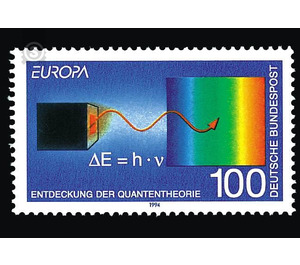Europe - Germany / Federal Republic of Germany 1994 - 100 Pfennig
Theme: Post & Philately
| Country | Germany / Federal Republic of Germany |
| Issue Date | 1994 |
| Face Value | 100.00 |
| Color | blue |
| Perforation | K 14 |
| Printing Type | Multicolor offset printing |
| Stamp Type | Postage stamp |
| Item Type | Stamp |
| Chronological Issue Number | 1606 |
| Chronological Chapter | GER-BRD |
| SID | 75266 |
| In 57 Wishlists | |
At the beginning of this century, the worldview of classical physics was shaken to its foundations, the era of modern physics began. The discovery of quantum theory, like Einstein's Theory of Relativity, required a abandonment of familiar schemata of thought and opened up entirely new insights into nature. The quantum theory was born on 14 December 1900, when Max Planck (Kiel 1858-1947 Göttingen, Nobel Prize 1918) in front of the German Physical Society for the first time succeeded in explaining the thermal radiation of a black body. All attempts to describe the spectrum of this radiation by the means of classical physics had led to nonsensical results. At this historic meeting, Planck hypothesized that the radiant energy could only be absorbed and released in portions ("quanta"), more precisely in units of a constant h x of the frequency v of the radiation. This assumption meant something fundamentally new. So far, one has always proceeded from the continuous running of all processes, so nature should now suddenly make leaps! Even Planck thought this thought so incredible that he tried for a long time - in vain - to find a less revolutionary explanation. The radical break with the traditional idea was very difficult for the rather conservative Planck personally. Years later, when asked about his discovery, he described the quantum hypothesis as an "act of despair." Planck, as the father of the new theory, occupied an outstanding position among German physicists. In 1930 he took over the presidium of the Kaiser Wilhelm Society in Berlin, today renamed the Max Planck Society. With Planck's discovery, a stormy development of quantum theory began. Numerous physicists like Bohr, Born, Heisenberg, Schrödinger and others have developed them into a sustainable theory up to the present day. It explains the processes in the microcosm as well as the structure of the atoms and determines our idea of the structure of matter. The fact that the quantum phenomena do not appear in our macroscopic everyday world is due to the smallness of the natural constant h, the so-called Planck quantum of action. The questions raised by quantum theory go far into the philosophical realm. B. the question of the objectivity of the measurement process. In addition to the important findings for the physical fundamentals, quantum theory has also led to numerous applications. The development of the laser provides an impressive example of this. (Text: Physics Institute Bonn, Ariane Frey)


